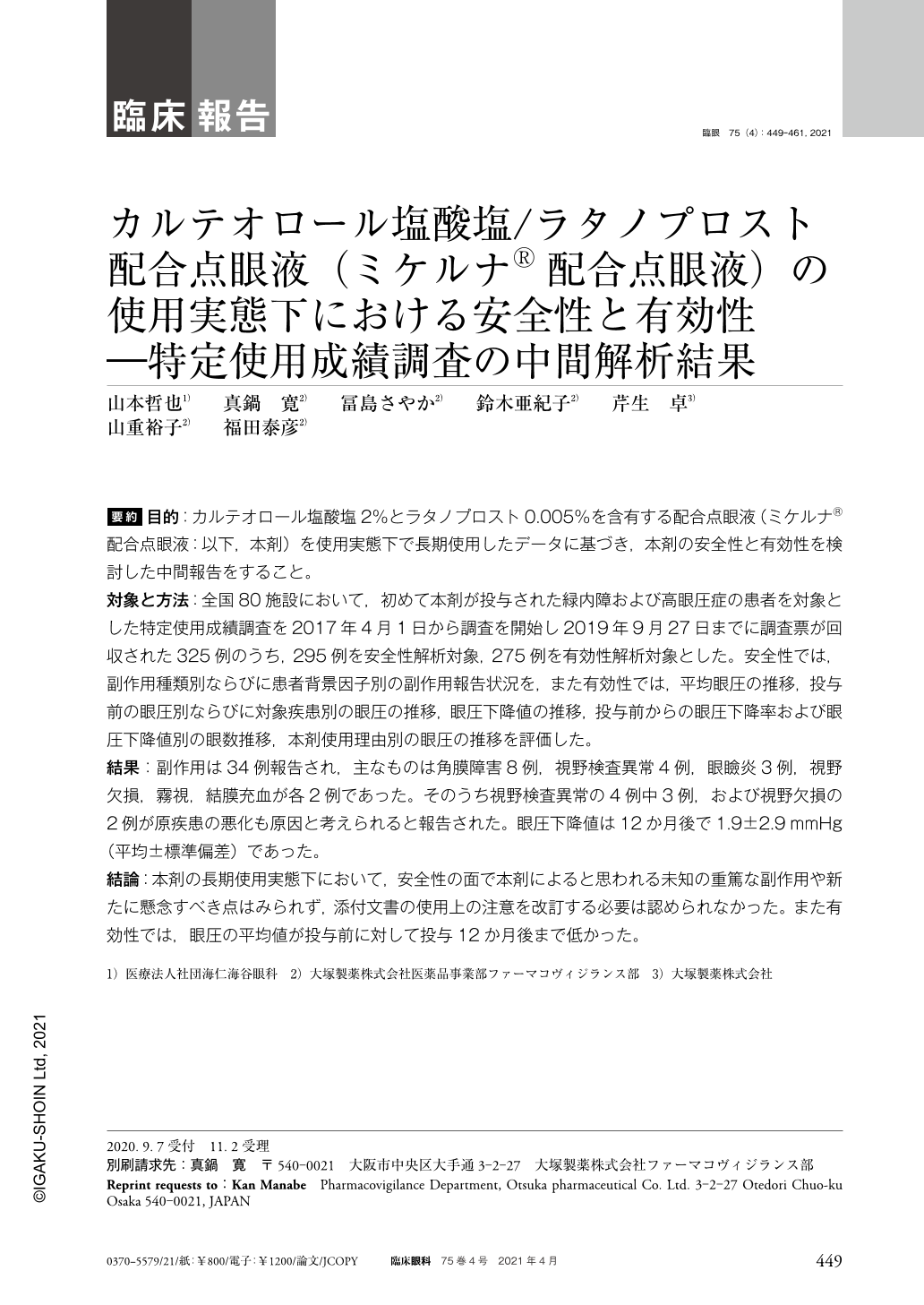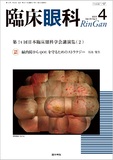Japanese
English
- 有料閲覧
- Abstract 文献概要
- 1ページ目 Look Inside
- 参考文献 Reference
要約 目的:カルテオロール塩酸塩2%とラタノプロスト0.005%を含有する配合点眼液(ミケルナ®配合点眼液:以下,本剤)を使用実態下で長期使用したデータに基づき,本剤の安全性と有効性を検討した中間報告をすること。
対象と方法:全国80施設において,初めて本剤が投与された緑内障および高眼圧症の患者を対象とした特定使用成績調査を2017年4月1日から調査を開始し2019年9月27日までに調査票が回収された325例のうち,295例を安全性解析対象,275例を有効性解析対象とした。安全性では,副作用種類別ならびに患者背景因子別の副作用報告状況を,また有効性では,平均眼圧の推移,投与前の眼圧別ならびに対象疾患別の眼圧の推移,眼圧下降値の推移,投与前からの眼圧下降率および眼圧下降値別の眼数推移,本剤使用理由別の眼圧の推移を評価した。
結果:副作用は34例報告され,主なものは角膜障害8例,視野検査異常4例,眼瞼炎3例,視野欠損,霧視,結膜充血が各2例であった。そのうち視野検査異常の4例中3例,および視野欠損の2例が原疾患の悪化も原因と考えられると報告された。眼圧下降値は12か月後で1.9±2.9mmHg(平均±標準偏差)であった。
結論:本剤の長期使用実態下において,安全性の面で本剤によると思われる未知の重篤な副作用や新たに懸念すべき点はみられず,添付文書の使用上の注意を改訂する必要は認められなかった。また有効性では,眼圧の平均値が投与前に対して投与12か月後まで低かった。
Abstract Objective:To provide an interim report of the safety and efficacy of a fixed combination ophthalmic solution containing 2% of carteolol hydrochloride and 0.005% of latanoprost(Mikeluna®, hereinafter referred to as“this drug”)in the long-term use under actual use conditions.
Subjects and methods:This specified drug use survey was conducted in patients with glaucoma and ocular hypertension to whom this drug was administered for the first time at 80 facilities nationwide from April 1, 2017. Data were collected from 325 patients until September 27, 2019, and 295 cases were included in the safety analysis and 275 cases in the efficacy analysis. In the safety analysis, adverse drug reactions and patient background factors were evaluated. In the efficacy analysis, the time course of the mean intraocular pressure(IOP), the time course of the mean IOP in subgroup analysis based on IOP before administration(defined as baseline)and diagnosis, the adjusted mean IOP reduction from baseline, the number and percentage of eyes that achieved the target of IOP reduction from baseline, and the time course of mean IOP based on the reason for using this drug were evaluated.
Results:In the safety analysis, 34 adverse drug reactions were reported, including corneal disorders(8 cases), abnormalities in visual field tests(4 cases), blepharitis(3 cases), and visual field defects, blurred vision, and conjunctival hyperemia(2 cases each). Three of 4 cases with visual field abnormalities and all cases with visual field defects were also attributed to exacerbation of the underlying diseases. In the efficacy analysis, the IOP reduction from baseline at 12 months after starting administration was 1.9±2.9 mmHg(mean±standard deviation).
Conclusion:In terms of safety, there were no serious unexpected adverse drug reactions and new concerns and it was not necessary to revise precautions in the package insert. As for efficacy, the mean IOP was lower than baseline during the 12 months after starting administration.

Copyright © 2021, Igaku-Shoin Ltd. All rights reserved.


